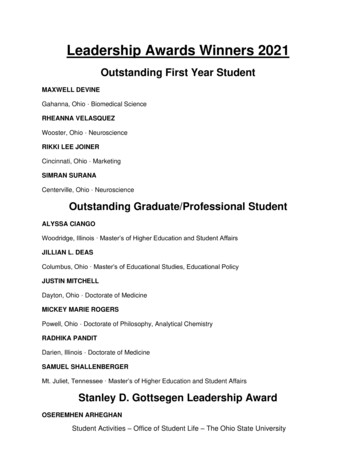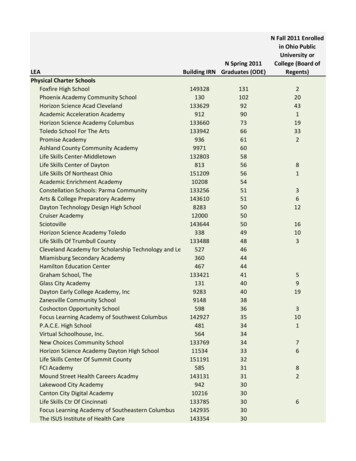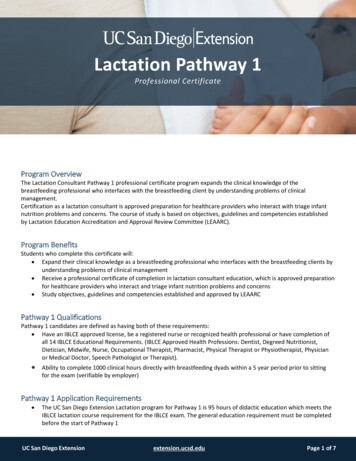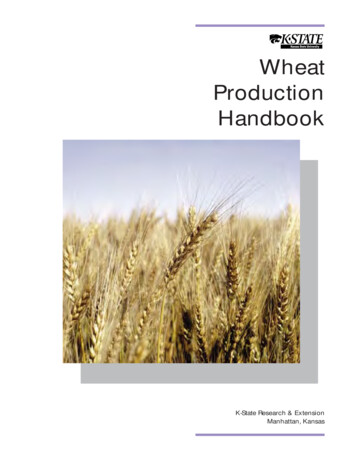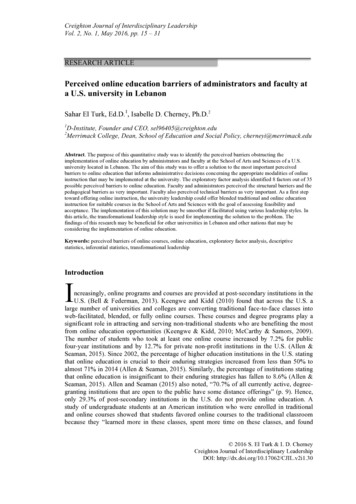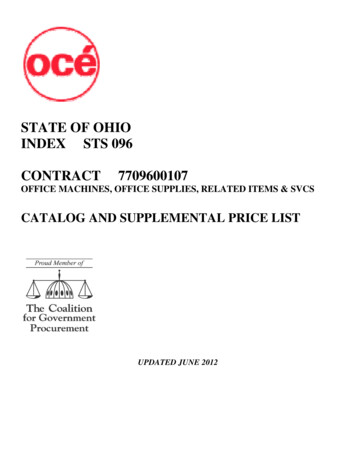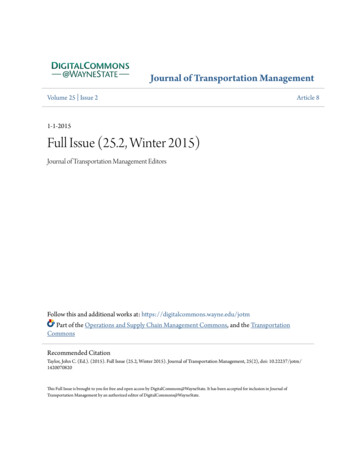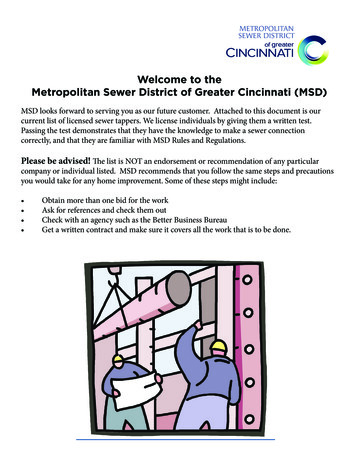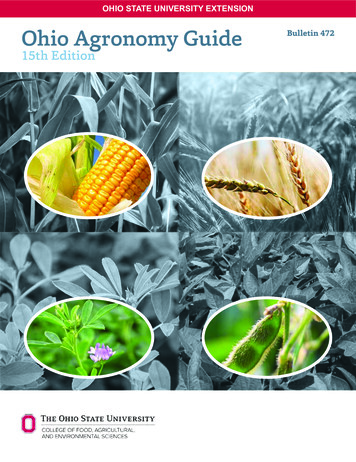
Transcription
OHIO STATE UNIVERSITY EXTENSIONOhio Agronomy Guide15th EditionBulletin 472
Ohio Agronomy Guide, 15th EditionTo: Ohio Farmers and Agricultural Industry PersonnelFrom: The AuthorsThe agronomic crop scientists at The Ohio State University arepleased to present the 15th edition of the Ohio Agronomy Guide.First published in 1966, the Ohio Agronomy Guide continues toserve as the official compilation of adaptive research results andrecommendations from research and educational programs.Ohio agronomic research programs are designed to determine responsesof various crops and cropping systems to management practices and resourceinputs, as well as to understand the basic biological and chemical mechanisms responsible for these responses. This basic research thrust allows us to model cropping systems and predicttheir behavior under a variety of management schemes. Our aim is also to continue developing technologies and cropping systems that are efficient in capturing solar energy, sustainable over time, and environmentally compatible.This 15th edition contains updates to the previous publication. Additionally, three new chapters have beenadded: “Considerations for Using Cover Crops” (Chapter 10), “Conducting On-Farm Research” (Chapter 11),and “Precision Agriculture” (Chapter 12). We will continue to supplement the information in this guide withother publications and fact sheets as necessary. For additional details and assistance, contact your localcounty Extension educator or one of the authors. We welcome your suggestions and input for improvement of both this publication and our research and educational programs.AuthorsDr. David J. BarkerDr. Steve CulmanDr. Anne DorranceDr. John FultonDr. Ryan HadenDr. Edwin LentzDr. Alex LindseyDr. Laura LindseyDr. Mark LouxDr. Ed McCoyDr. Andy MichelMr. Jim NoelDr. Pierce PaulDr. R. Mark SulcDr. Peter ThomisonDr. Kelley TilmonDr. Jon WitterHorticulture and Crop ScienceEnvironment and Natural ResourcesPlant PathologyFood, Agricultural, and Biological EngineeringAgricultural Technical InstituteExtensionHorticulture and Crop ScienceHorticulture and Crop ScienceHorticulture and Crop ScienceEnvironment and Natural ResourcesEntomologyNOAA/NWS/Ohio River Forecast CenterPlant PathologyHorticulture and Crop ScienceHorticulture and Crop ScienceEntomologyAgricultural Technical InstituteAcknowledgmentsWe would also like to thank Marketing and Communications for text editing, layout anddevelopment of illustrations.Copyright 2017, 2005, The Ohio State UniversityOhio State University Extension embraces human diversity and is committed to ensuring that all research and related educational programs areavailable to clientele on a nondiscriminatory basis without regard to age, ancestry, color, disability, gender identity or expression, genetic information, HIV/AIDS status, military status, national origin, race, religion, sex, sexual orientation, or veteran status. This statement is in accordance withUnited States Civil Rights Laws and the USDA.Roger Rennekamp, Associate Dean and Director, Ohio State University ExtensionFor Deaf and Hard of Hearing, please contact Ohio State University Extension using your preferred communication (e-mail, relay services, or videorelay services). Phone 1-800-750-0750 between 8 a.m. and 5 p.m. EST Monday through Friday. Inform the operator to dial 614-292-6181.3/17—3M—Globus
ContentsChapter 1 - Ohio’s Climate and Soil . . . . . . . . . . 1Soil Formation and Soil Properties . . . . . . . . . . . . . . . . . . . . 5Soil Properties and Crop Management . . . . . . . . . . . . . . . . 5Organic Matter Content . . . . . . . . . . . . . . . . . . . . . . . . . . . 5Soil Texture . . . . . . . . . . . . . . . . . . . . . . . . . . . . . . . . . . . . . . 6Subsoil pH . . . . . . . . . . . . . . . . . . . . . . . . . . . . . . . . . . . . . . . 7Soil Water Available to Plants . . . . . . . . . . . . . . . . . . . . . . 7Slope of the Topography . . . . . . . . . . . . . . . . . . . . . . . . . . 9Natural Soil Drainage . . . . . . . . . . . . . . . . . . . . . . . . . . . . . 9Ohio Soil Regions . . . . . . . . . . . . . . . . . . . . . . . . . . . . . . . . . 10Available Data on Soil Properties . . . . . . . . . . . . . . . . . . . . . 11Chapter 2 - Soil and Water Management . . . 12Drainage—The Critical Factor . . . . . . . . . . . . . . . . . . . . . . . 12Two-Stage Drainage Ditches . . . . . . . . . . . . . . . . . . . . . . . . 13Managing Soil Structure . . . . . . . . . . . . . . . . . . . . . . . . . . . . 13Efficient Water Use . . . . . . . . . . . . . . . . . . . . . . . . . . . . . . . . 14Irrigation . . . . . . . . . . . . . . . . . . . . . . . . . . . . . . . . . . . . . . . . . 15Soil Conservation . . . . . . . . . . . . . . . . . . . . . . . . . . . . . . . . . 15Conservation Practices . . . . . . . . . . . . . . . . . . . . . . . . . . . . .15Conservation Tillage and No-Till . . . . . . . . . . . . . . . . . . . . 16Basics of Conservation Tillage . . . . . . . . . . . . . . . . . . . . 16Drainage . . . . . . . . . . . . . . . . . . . . . . . . . . . . . . . . . . . . . . . 16Soils . . . . . . . . . . . . . . . . . . . . . . . . . . . . . . . . . . . . . . . . . . . 16Compaction Considerations . . . . . . . . . . . . . . . . . . . . . . 16Cover Crops . . . . . . . . . . . . . . . . . . . . . . . . . . . . . . . . . . . . 17Planting . . . . . . . . . . . . . . . . . . . . . . . . . . . . . . . . . . . . . . . . 17Fertilization . . . . . . . . . . . . . . . . . . . . . . . . . . . . . . . . . . . . . 17Soil Testing . . . . . . . . . . . . . . . . . . . . . . . . . . . . . . . . . . . . . 17Weed Control . . . . . . . . . . . . . . . . . . . . . . . . . . . . . . . . . . . 18Considerations for Crop Production on Mine soils . . . . . 18Chapter 3 - Soil Fertility . . . . . . . . . . . . . . . . . . 20Elements Essential for Plant Growth . . . . . . . . . . . . . . . . . 204Rs of Nutrient Management . . . . . . . . . . . . . . . . . . . . . . . 21Primary Macronutrients . . . . . . . . . . . . . . . . . . . . . . . . . . . 22Secondary Macronutrients . . . . . . . . . . . . . . . . . . . . . . . . 23Micronutrients . . . . . . . . . . . . . . . . . . . . . . . . . . . . . . . . . . . 23Animal Manure . . . . . . . . . . . . . . . . . . . . . . . . . . . . . . . . . . 24Calculating Fertilizer Rates . . . . . . . . . . . . . . . . . . . . . . . . 24Lime and Liming Materials . . . . . . . . . . . . . . . . . . . . . . . . . . 24Liming Materials . . . . . . . . . . . . . . . . . . . . . . . . . . . . . . . . 24Determination of Lime Requirement . . . . . . . . . . . . . . . 25Lime Recommendations . . . . . . . . . . . . . . . . . . . . . . . . . . 25Adjustments for the Type of Liming Material . . . . . . . . 25Adjust for the Depth of Tillage . . . . . . . . . . . . . . . . . . . . 25No-Till Adjustments . . . . . . . . . . . . . . . . . . . . . . . . . . . . . 26Other Adjustments in Lime Recommendations . . . . . 26Acidic Subsoils . . . . . . . . . . . . . . . . . . . . . . . . . . . . . . . . . 26Organic Soils (Muck and/or Peat) . . . . . . . . . . . . . . . . . . 26High Organic Matter Soils . . . . . . . . . . . . . . . . . . . . . . . . 26Diagnostic Methods . . . . . . . . . . . . . . . . . . . . . . . . . . . . . . . 26Soil Testing . . . . . . . . . . . . . . . . . . . . . . . . . . . . . . . . . . . . . 26Soil Sampling . . . . . . . . . . . . . . . . . . . . . . . . . . . . . . . . . . . 27Soil pH and Buffer pH . . . . . . . . . . . . . . . . . . . . . . . . . . . . 28Cation Exchange Capacity . . . . . . . . . . . . . . . . . . . . . . . . 28Available Phosphorus . . . . . . . . . . . . . . . . . . . . . . . . . . . . 28Exchangeable Calcium, Magnesium andPotassium . . . . . . . . . . . . . . . . . . . . . . . . . . . . . . . . . . . . . . 28Calcium to Magnesium Ratio . . . . . . . . . . . . . . . . . . . . . . 28Magnesium to Potassium Ratio . . . . . . . . . . . . . . . . . . . . 28Soluble Salts . . . . . . . . . . . . . . . . . . . . . . . . . . . . . . . . . . . . 29Soil Health Assessment . . . . . . . . . . . . . . . . . . . . . . . . . . 29Plant Tissue Sampling and Analysis . . . . . . . . . . . . . . . . 29Optical Sensing of Leaf Chlorophyll andNitrogen Status Using NDVI Sensors . . . . . . . . . . . . . . . 30Interpretation of Recommendations . . . . . . . . . . . . . . . . . 31Chapter 4 - Corn Production . . . . . . . . . . . . . . 32How Climate Affects Corn Production . . . . . . . . . . . . . . . . 32Temperature . . . . . . . . . . . . . . . . . . . . . . . . . . . . . . . . . . . . 32Precipitation . . . . . . . . . . . . . . . . . . . . . . . . . . . . . . . . . . . . 32Corn Growth and Development . . . . . . . . . . . . . . . . . . . . . 33Hybrid Selection . . . . . . . . . . . . . . . . . . . . . . . . . . . . . . . . . 35Maturity . . . . . . . . . . . . . . . . . . . . . . . . . . . . . . . . . . . . . . . . 36Days to Maturity Rating System . . . . . . . . . . . . . . . . . . . 36Growing Degree Day (GDD) MaturityRating System . . . . . . . . . . . . . . . . . . . . . . . . . . . . . . . . . . . 36Yield Potential and Stability . . . . . . . . . . . . . . . . . . . . . . . 37Stalk Quality and Lodging . . . . . . . . . . . . . . . . . . . . . . . . 38Disease Resistance and Tolerance . . . . . . . . . . . . . . . . . 38Grain Quality . . . . . . . . . . . . . . . . . . . . . . . . . . . . . . . . . . . . 38Date of Planting . . . . . . . . . . . . . . . . . . . . . . . . . . . . . . . . . 38Seeding Depth . . . . . . . . . . . . . . . . . . . . . . . . . . . . . . . . . . 40Row Width . . . . . . . . . . . . . . . . . . . . . . . . . . . . . . . . . . . . . . 41Plant Populations and Seeding Rates . . . . . . . . . . . . . . 41Making Replant Decisions . . . . . . . . . . . . . . . . . . . . . . . . 44Fertility Recommendations . . . . . . . . . . . . . . . . . . . . . . . . . 45Nitrogen . . . . . . . . . . . . . . . . . . . . . . . . . . . . . . . . . . . . . . . . 45Timing and Sources . . . . . . . . . . . . . . . . . . . . . . . . . . . . 45Rates . . . . . . . . . . . . . . . . . . . . . . . . . . . . . . . . . . . . . . . . . 45Phosphorus and Potassium . . . . . . . . . . . . . . . . . . . . . . . 45Application Methods . . . . . . . . . . . . . . . . . . . . . . . . . . . 45Sources . . . . . . . . . . . . . . . . . . . . . . . . . . . . . . . . . . . . . . 45Rates . . . . . . . . . . . . . . . . . . . . . . . . . . . . . . . . . . . . . . . . . 45Sulfur . . . . . . . . . . . . . . . . . . . . . . . . . . . . . . . . . . . . . . . . . . 47Crop Rotations . . . . . . . . . . . . . . . . . . . . . . . . . . . . . . . . . . 47Corn Pest Management . . . . . . . . . . . . . . . . . . . . . . . . . . . . 47Weed Control . . . . . . . . . . . . . . . . . . . . . . . . . . . . . . . . . . . 47Insect Control . . . . . . . . . . . . . . . . . . . . . . . . . . . . . . . . . . . 47Disease Management . . . . . . . . . . . . . . . . . . . . . . . . . . . . 49Harvesting . . . . . . . . . . . . . . . . . . . . . . . . . . . . . . . . . . . . . . . . 50Test Weight and Shelled Corn Grades . . . . . . . . . . . . . . 51Ear Corn . . . . . . . . . . . . . . . . . . . . . . . . . . . . . . . . . . . . . . . . 52Corn Silage . . . . . . . . . . . . . . . . . . . . . . . . . . . . . . . . . . . . . 52Specialty Corns . . . . . . . . . . . . . . . . . . . . . . . . . . . . . . . . . . . 53Isolation Requirements for Identity Preserved (IP)Non-GMO Corn Production . . . . . . . . . . . . . . . . . . . . . . . . . 54Chapter 5 - Soybean Production . . . . . . . . . . 56Variety Selection . . . . . . . . . . . . . . . . . . . . . . . . . . . . . . . . . .Variety Performance Trials . . . . . . . . . . . . . . . . . . . . . . . . . .Disease Control . . . . . . . . . . . . . . . . . . . . . . . . . . . . . . . . . . .Crop Rotation . . . . . . . . . . . . . . . . . . . . . . . . . . . . . . . . . . . . .Tillage . . . . . . . . . . . . . . . . . . . . . . . . . . . . . . . . . . . . . . . . . . .5656565858i
Producing Soybeans Without Tillage . . . . . . . . . . . . . . . . 59Rhizobium Inoculation . . . . . . . . . . . . . . . . . . . . . . . . . . . . . . 60Planting Date . . . . . . . . . . . . . . . . . . . . . . . . . . . . . . . . . . . . . 60Late Planting . . . . . . . . . . . . . . . . . . . . . . . . . . . . . . . . . . . . . . 61Row Spacing . . . . . . . . . . . . . . . . . . . . . . . . . . . . . . . . . . . . . . 61Plant Population . . . . . . . . . . . . . . . . . . . . . . . . . . . . . . . . . . . 62Replanting . . . . . . . . . . . . . . . . . . . . . . . . . . . . . . . . . . . . . . . . 62Planting Depth . . . . . . . . . . . . . . . . . . . . . . . . . . . . . . . . . . . . 63Fertilization Recommendations . . . . . . . . . . . . . . . . . . . . . 63Nitrogen (N) . . . . . . . . . . . . . . . . . . . . . . . . . . . . . . . . . . . . . 63Phosphorus (P) . . . . . . . . . . . . . . . . . . . . . . . . . . . . . . . . . . 64Potassium (K) . . . . . . . . . . . . . . . . . . . . . . . . . . . . . . . . . . . 64Calcium (Ca) and Magnesium (Mg) . . . . . . . . . . . . . . . . . 65Sulfur (S) . . . . . . . . . . . . . . . . . . . . . . . . . . . . . . . . . . . . . . . . 65Manganese (Mn) . . . . . . . . . . . . . . . . . . . . . . . . . . . . . . . . . 65Insect Control . . . . . . . . . . . . . . . . . . . . . . . . . . . . . . . . . . . . . 66Weed Control . . . . . . . . . . . . . . . . . . . . . . . . . . . . . . . . . . . . . 68Chapter 6 - Small Grain Production . . . . . . . . 69Wheat Production . . . . . . . . . . . . . . . . . . . . . . . . . . . . . . . . . 69Variety Selection . . . . . . . . . . . . . . . . . . . . . . . . . . . . . . . . 69High-Quality Seed and Seed Treatment . . . . . . . . . . . . 70Crop Rotation . . . . . . . . . . . . . . . . . . . . . . . . . . . . . . . . . . . 70Land Selection and Preparation . . . . . . . . . . . . . . . . . . . 70Planting Date . . . . . . . . . . . . . . . . . . . . . . . . . . . . . . . . . . . 70Seeding Practices . . . . . . . . . . . . . . . . . . . . . . . . . . . . . . . 71Producing Wheat in 15-Inch Rows . . . . . . . . . . . . . . . . . 72Lodging Control . . . . . . . . . . . . . . . . . . . . . . . . . . . . . . . 73Fertilization . . . . . . . . . . . . . . . . . . . . . . . . . . . . . . . . . . . . . 73Nitrogen (N) . . . . . . . . . . . . . . . . . . . . . . . . . . . . . . . . . . . 73Phosphorus (P) . . . . . . . . . . . . . . . . . . . . . . . . . . . . . . . . 74Potassium (K) . . . . . . . . . . . . . . . . . . . . . . . . . . . . . . . . . . 74Sulfur (S) . . . . . . . . . . . . . . . . . . . . . . . . . . . . . . . . . . . . . . 75Manganese (Mn) . . . . . . . . . . . . . . . . . . . . . . . . . . . . . . . 75Nutrient Value of Wheat Straw . . . . . . . . . . . . . . . . . . . . 75Disease Management . . . . . . . . . . . . . . . . . . . . . . . . . . . . 75Insect Control . . . . . . . . . . . . . . . . . . . . . . . . . . . . . . . . . . . 79Weed Control . . . . . . . . . . . . . . . . . . . . . . . . . . . . . . . . . . . 80Production of Other Small Grain Species . . . . . . . . . . . . . 80Weed Control for Small Grains . . . . . . . . . . . . . . . . . . . . 81Chapter 7 - Forage Production . . . . . . . . . . . . 82Perennial Forages . . . . . . . . . . . . . . . . . . . . . . . . . . . . . . . . .Species Selection . . . . . . . . . . . . . . . . . . . . . . . . . . . . . . .Agronomic Adaptation and Intended Use . . . . . . . .Pure Stands versus Mixtures . . . . . . . . . . . . . . . . . . . .Mixtures for Hay and Silage . . . . . . . . . . . . . . . . . . . .Mixtures for Pastures . . . . . . . . . . . . . . . . . . . . . . . . . .Seeding Rates . . . . . . . . . . . . . . . . . . . . . . . . . . . . . . . . .Examples of Seeding Rates for Mixtures . . . . . . . . . . . .Characteristics of Perennial Cool-Season Forages . . .Alfalfa (Medicago sativa L.) . . . . . . . . . . . . . . . . . . . . .Alsike Clover (Trifolium hybridum L.) . . . . . . . . . . . . . .Birdsfoot Trefoil (Lotus corniculatus L.) . . . . . . . . . . . .Red Clover (Trifolium pratense L.) . . . . . . . . . . . . . . . .White Clover (Trifolium repens L.) . . . . . . . . . . . . . . . .Festulolium (xFestulolium Asch. & Graebn.) . . . . . . .Kentucky Bluegrass (Poa pratensis L.) . . . . . . . . . . . .Meadow Fescue(Schedonorus pratensis (Huds.) . Beauv. . . . . . . . . .ii8282828285858686868686888888888989Orchardgrass (Dactylis glomerata L.) . . . . . . . . . . . . . 89Reed Canarygrass (Phalaris arundinacea L.) . . . . . . 89Ryegrass (Lolium species) . . . . . . . . . . . . . . . . . . . . . . . 90Smooth Bromegrass (Bromis inermis Leyss.) . . . . . . 90Tall Fescue (Schedonorus arundinaceus(Schreb.) Dumort., nom. cons.) . . . . . . . . . . . . . . . . . . . 90Timothy (Phleum pratense L.) . . . . . . . . . . . . . . . . . . . . 91Forage Species Identification . . . . . . . . . . . . . . . . . . . . . 91Printed publications: . . . . . . . . . . . . . . . . . . . . . . . . . . . 91Online resources: . . . . . . . . . . . . . . . . . . . . . . . . . . . . . . 91Pre-Establishment Fertilization and Liming . . . . . . . . . . 91Soil pH . . . . . . . . . . . . . . . . . . . . . . . . . . . . . . . . . . . . . . . 91Topsoil pH Levels for Forages: . . . . . . . . . . . . . . . . . . 91Phosphorus and Potassium . . . . . . . . . . . . . . . . . . . . . 91Sulfur . . . . . . . . . . . . . . . . . . . . . . . . . . . . . . . . . . . . . . . . 92Pre-Establishment Fertilization for No-till . . . . . . . . . . . 92Starter Nitrogen . . . . . . . . . . . . . . . . . . . . . . . . . . . . . . . 92Stand Establishment . . . . . . . . . . . . . . . . . . . . . . . . . . . . . 92Crop Rotation and Autotoxicity . . . . . . . . . . . . . . . . . . 93Seed Quality . . . . . . . . . . . . . . . . . . . . . . . . . . . . . . . . . . 93Seed Inoculation . . . . . . . . . . . . . . . . . . . . . . . . . . . . . . 93Seed Treatments . . . . . . . . . . . . . . . . . . . . . . . . . . . . . . 93Spring Seedings . . . . . . . . . . . . . . . . . . . . . . . . . . . . . . 93Late Summer Seedings . . . . . . . . . . . . . . . . . . . . . . . . 95Conventional Tillage Seeding . . . . . . . . . . . . . . . . . . . 95No-Till and Minimum-Till Seeding . . . . . . . . . . . . . . . 95Seeding-Year Harvest Management . . . . . . . . . . . . . . . 96Fertilizing Established Stands . . . . . . . . . . . . . . . . . . . . . 96Timing Topdress Phosphorus and PotassiumApplications . . . . . . . . . . . . . . . . . . . . . . . . . . . . . . . . . . 96Nitrogen Fertilization . . . . . . . . . . . . . . . . . . . . . . . . . . 96Sulfur Fertilization . . . . . . . . . . . . . . . . . . . . . . . . . . . . . 97Micronutrients . . . . . . . . . . . . . . . . . . . . . . . . . . . . . . . . 97Grass Tetany . . . . . . . . . . . . . . . . . . . . . . . . . . . . . . . . . . 97Established Stand Harvest Management . . . . . . . . . . . 97First Harvest Timing . . . . . . . . . . . . . . . . . . . . . . . . . . . 97Summer Harvest Timing . . . . . . . . . . . . . . . . . . . . . . . 98Intensive Cutting for High Quality . . . . . . . . . . . . . . . 98Fall Harvesting . . . . . . . . . . . . . . . . . . . . . . . . . . . . . . . . 98Minimizing Fall Harvesting Hazard toTall Legumes . . . . . . . . . . . . . . . . . . . . . . . . . . . . . . . . . . 98Weed Management in Forages . . . . . . . . . . . . . . . . . . . . 99Insect Pest Management . . . . . . . . . . . . . . . . . . . . . . . . . 99Disease Management in Forages . . . . . . . . . . . . . . . . . . 99Preserving Forage as Hay and Silage . . . . . . . . . . . . . 100Perennial Warm-Season Grasses . . . . . . . . . . . . . . . . . 101Establishment . . . . . . . . . . . . . . . . . . . . . . . . . . . . . . . . 101Managing Established Stands . . . . . . . . . . . . . . . . . 102Annual Forage Crops . . . . . . . . . . . . . . . . . . . . . . . . . . . . . 102Corn Silage . . . . . . . . . . . . . . . . . . . . . . . . . . . . . . . . . . . . 102Small Grains for Forage . . . . . . . . . . . . . . . . . . . . . . . . . 102Establishment and Fertilization . . . . . . . . . . . . . . . . 103Harvest Management . . . . . . . . . . . . . . . . . . . . . . . . . 103Grazing Management . . . . . . . . . . . . . . . . . . . . . . . . . 103Animal Health Concerns with Small Grains . . . . . . . 103Italian Ryegrass . . . . . . . . . . . . . . . . . . . . . . . . . . . . . . . . 103Summer-Annual Grasses . . . . . . . . . . . . . . . . . . . . . . . . 104Establishment . . . . . . . . . . . . . . . . . . . . . . . . . . . . . . . . 105Fertilization . . . . . . . . . . . . . . . . . . . . . . . . . . . . . . . . . . 105
Harvest Management . . . . . . . . . . . . . . . . . . . . . . . . . 105Animal Health Concerns . . . . . . . . . . . . . . . . . . . . . . 106Reducing the Risk of Prussic Acid Poisoningin Sorghum Species . . . . . . . . . . . . . . . . . . . . . . . . . . . 107Brassica Crops . . . . . . . . . . . . . . . . . . . . . . . . . . . . . . . . . 107Establishment . . . . . . . . . . . . . . . . . . . . . . . . . . . . . . . . 108Fertilization . . . . . . . . . . . . . . . . . . . . . . . . . . . . . . . . . . 108Harvesting . . . . . . . . . . . . . . . . . . . . . . . . . . . . . . . . . . 108Animal Health Concerns with Brassicas . . . . . . . . . 108Chapter 8 - Multiple Cropping . . . . . . . . . . . . 110Multiple Cropping Requirements . . . . . . . . . . . . . . . . . . . 110Double Cropping with Forages . . . . . . . . . . . . . . . . . . . 110Double Cropping Wheat and Soybean . . . . . . . . . . . . . 111Relay Intercropping Wheat and Soybean . . . . . . . . . . 112Emergency Aerial Seeding . . . . . . . . . . . . . . . . . . . . . . . . 113Step 2: Conduct a Two-Way Analysis ofVariance (ANOVA) Test . . . . . . . . . . . . . . . . . . . . . . . . 137Summary . . . . . . . . . . . . . . . . . . . . . . . . . . . . . . . . . . . . . . . . 139Chapter 12 - Precision Agriculture . . . . . . . . 140Precision Agriculture Technologies . . . . . . . . . . . . . . . . . 140Benefits of Precision Agriculture . . . . . . . . . . . . . . . . . . . 143Appendix - English and MetricConversion . . . . . . . . . . . . . . . . . . . . . . . . . . . . 144English to Metric . . . . . . . . . . . . . . . . . . . . . . . . . . . . . . . . 144English to English . . . . . . . . . . . . . . . . . . . . . . . . . . . . . . . 144Metric to Metric . . . . . . . . . . . . . . . . . . . . . . . . . . . . . . . . . 145Metric to English . . . . . . . . . . . . . . . . . . . . . . . . . . . . . . . . 145Useful Tables: Adjustments and Conversions . . . . . . 146Bushels, Test Weights and Calculations . . . . . . . . . . . . . 147Chapter 9 - Pasture andGrazing Management . . . . . . . . . . . . . . . . . . . . 114Grazing Systems . . . . . . . . . . . . . . . . . . . . . . . . . . . . . . . . . 114Stocking Rate . . . . . . . . . . . . . . . . . . . . . . . . . . . . . . . . . . . . 114Grazing Management . . . . . . . . . . . . . . . . . . . . . . . . . . . . . 116Feed Budgeting . . . . . . . . . . . . . . . . . . . . . . . . . . . . . . . . . . . 117Improving Production . . . . . . . . . . . . . . . . . . . . . . . . . . . . . 118Fertilization . . . . . . . . . . . . . . . . . . . . . . . . . . . . . . . . . . . . 118Weed Control . . . . . . . . . . . . . . . . . . . . . . . . . . . . . . . . . . 118Pasture Renovation . . . . . . . . . . . . . . . . . . . . . . . . . . . . . 119First Year Management of Renovated Pastures . . . . . . . 119Pasture Species and Cultivar Selection . . . . . . . . . . . . 119Cool-Season Grass Species . . . . . . . . . . . . . . . . . . . . . 120Legumes . . . . . . . . . . . . . . . . . . . . . . . . . . . . . . . . . . . . . . 121Other Species . . . . . . . . . . . . . . . . . . . . . . . . . . . . . . . . . . 121Mixtures . . . . . . . . . . . . . . . . . . . . . . . . . . . . . . . . . . . . . . . 122Toxicity . . . . . . . . . . . . . . . . . . . . . . . . . . . . . . . . . . . . . . . . . . 122Chapter 10 - Considerations forUsing Cover Crops . . . . . . . . . . . . . . . . . . . . . 124Why are Cover Crops Needed, and What SpeciesShould I Use? . . . . . . . . . . . . . . . . . . . . . . . . . . . . . . . . . . . . 124Economic Considerations . . . . . . . . . . . . . . . . . . . . . . . . . 127Establishing a Cover Crop Stand . . . . . . . . . . . . . . . . . . . 127Cover Crop Implementation . . . . . . . . . . . . . . . . . . . . . 127Planting Methods and Procedures . . . . . . . . . . . . . . . 128Terminating a Cover Crop Stand . . . . . . . . . . . . . . . . . . 129Summary . . . . . . . . . . . . . . . . . . . . . . . . . . . . . . . . . . . . . . . . 130Chapter 11 - Conducting On-FarmResearch . . . . . . . . . . . . . . . . . . . . . . . . . . . . . . 131Determining Your Goal, Research Questionand Treatments . . . . . . . . . . . . . . . . . . . . . . . . . . . . . . . . . . 131Trial Design and Replication are Key . . . . . . . . . . . . . . . . 131So How Do I Make Sense of the Data? . . . . . . . . . . . . . . 133Performing the Data Analysis–A Few Examples . . . . 133Example 1: Paired t-Test Analysis . . . . . . . . . . . . . . . . . 134Step 1: Data Entry . . . . . . . . . . . . . . . . . . . . . . . . . . . . . 134Step 2: Data Analysis . . . . . . . . . . . . . . . . . . . . . . . . . . 134Example 2: Calculation of an LSD from anExperiment Using Randomized CompleteBlock Design . . . . . . . . . . . . . . . . . . . . . . . . . . . . . . . . . . . 136Step 1: Enter Data into Excel . . . . . . . . . . . . . . . . . . . . 137iii
Chapter 1Ohio’s Climate and SoilBy Mr. Jim Noel and Dr. Ed McCoyOHIO IS SITUATED between the Appalachian Mountainsto the east, the Gulf of Mexico to the south and the GreatLakes to the north. In addition, the Ohio Valley is nearthe jet stream where the warm moisture air to the southcollides with the colder and drier air from Canada. This isa perfect setup for a storm track through the region. ForOhio, this means frequent periods of wet conditions mixedwith short but intense dry periods in an overall activeweather and climate environment. This active environmentyields severe storms, floods, droughts, and almost theentire climate spectrum.Mean annual air temperatures for Ohio are in the lower50s but have steadily increased from about 50 degreesFahrenheit prior to 1975 to near 52 degrees Fahrenheittoday (Figure 1-1).Figure 1-1. Ohio mean annual temperatures 1895-2015.Source: NOAA NCEI, ncdc.noaa.gov/temp-and-precip/state-temps/.Ohio Agronomy Guide, 15th Edition1
Typical winter maximum temperatures are in the 30s(lower north and upper south) to the 80s in summer (lower north and upper south). Typical winterminimum temperatures are in the upper teens innorthern Ohio to the 20s in southern Ohio. Minimumtemperatures reach a peak in the summer in the 60s(lower north to upper south).Normal annual precipitation ranges from below 35inches in northwest Ohio to just below 45 inchesnear the Ohio River (Figure 1-2).Figure 1-2. Ohio annual precipitation. Source: NOAAMidwestern Regional Climate Center.Illinois State Water Survey, Prairie Research Institute,University of Illinois at Urbana-Champaign, mrcc.isws.illinois.edu/.Ohio’s annual snowfall is greatly impacted by acombination of lake effect snow off the Great Lakes,especially Lake Erie, and the storm track up the OhioValley. Snowfall ranges from below 20 inches insouthern Ohio to 30 to 50 inches in northern Ohio.Snowfall tops 80 inches annually in lake effect areasof northeast Ohio (Figure 1-3. mrcc.isws.illinois.edu/).Figure 1-3. Ohio annual snowfall. Source: NOAAMidwestern Regional Climate Center. Illinois StateWater Survey, Prairie Research Institute, Universityof Illinois at Urbana-Champaign, mrcc.isws.illinois.edu/.2Ohio Agronomy Guide, 15th Edition
In autumn, the median date of the first freeze ranges from before October 10th in northwest Ohio toafter October 20th in parts of southern Ohio and near Lake Erie around Cleveland (Figure 1-4).Figure 1-4. Ohio median date forfirst freeze autumn (32 F). Source:NOAA Midwestern RegionalClimate Center. Illinois StateWater Survey, Prairie ResearchInstitute, University of Illinois atUrbana-Champaign,mrcc.isws.illinois.edu.In spring, the median date of the last freeze ranges from around April 15th in southern Ohio to April 25th in northernOhio. However, in far northwest Ohio and northeast Ohio this date often is not reached until early May (Figure 1-5).Figure 1-5. Ohio median date forlast freeze spring (32 F). Source:NOAA Midwestern RegionalClimate Center. Illinois StateWater Survey, Prairie ResearchInstitute, University of Illinois atUrbana-Champaign.Ohio Agronomy Guide, 15th Edition3
Droughts in Ohio from a climate perspective tend to beshort in duration compared to other parts of the countryand world. Ohio typically experiences drought on a timescale most often less than one year in duration and tendto have a fast onset, be intense, and then quickly end. Thishas a lot to do with the location of Ohio relative to moisture sources such as the Gulf of Mexico and the AtlanticOcean. Further, the active jet stream nearby tends to keepdroughts short-lived in Ohio. Droughts most often occur inOhio in the warm season when high temperatures combine with excessive evapotranspiration loss for onset ofrapid drought.During the growing season from April to September, soilstransition from wet to drier. Most soils in Ohio are saturated during March and early April. Although growing seasonrainfall varies from 18 to 26 inches on average, it may notbe adequate for maximum yield unless effective water
Ohio Agronomy Guide, 15th Edition 3 In autumn , the median date of the rst freeze ranges from before October 10th in northwest Ohio to after October 20th in parts of southern Ohio and near Lake Erie around Cleveland (Figure 1-4). In spring , the median date of the last freeze ranges from aro
